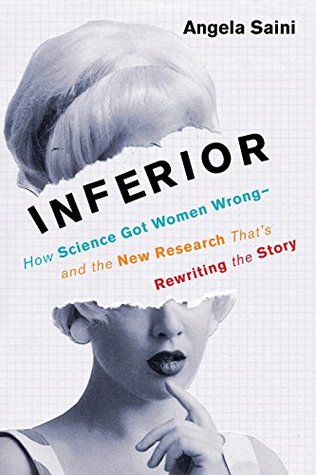More on this book
Community
Kindle Notes & Highlights
by
Angela Saini
Read between
March 8 - March 18, 2021
We think the scientific method can’t be biased or loaded against women. But we’re wrong. The puzzle of why there are so few women in the sciences is crucial to understanding why, not because it tells us something about what women are capable of but because it explains why science has failed to rid us of the gender stereotypes and dangerous myths we’ve been laboring under for centuries.
Women are so grossly underrepresented in modern science because, for most of history, they were treated as intellectual inferiors and deliberately excluded from it. It should come as no surprise, then, that this same scientific establishment has also painted a distorted picture of the female sex. This, in turn again, has skewed how science looks and what it says even now.
Imbalance in the sciences is at least partly because women face a web of pressures throughout their lives, which men often don’t face.
Even assuming she was given the same schooling as a boy, it was unusual for a girl to be allowed into universities or granted degrees until the twentieth century. “From their beginnings European universities were, in principle, closed to women,” writes Schiebinger. They were designed to prepare men for careers in theology, law, government, and medicine, which women were barred from entering. Doctors argued that the mental strains of higher education might divert energy away from a woman’s reproductive system, harming her fertility.
This doesn’t mean that female scientists didn’t exist. They did. Many even succeeded against the odds. But they were often treated as outsiders and routinely overlooked for honors. The most famous example is Marie Curie, the first person to win two Nobel Prizes, but nevertheless denied from becoming a member of France’s Academy of Sciences in 1911 because she was a woman.
In the history of science, we have to hunt for the women—not because they weren’t capable of doing research but because for such a large chunk of time they didn’t have the chance. We’re still living with the legacy of an establishment that’s just beginning to recover from centuries of entrenched exclusion and prejudice.
Having more women in science is already changing how science is done. Questions are being asked that were never asked before. Assumptions are being challenged. Old ideas are giving way to new ones. The distorted, often negative picture that research has painted of women in the past has been powerfully challenged in recent decades by other researchers—many of whom are women. And this alternative portrait shows humans in a completely different light.
For me, this struggle represents the final frontier for feminism. It has the potential to knock down the greatest barrier that stands between women and full equality—the one in our minds.
You cannot overestimate how important Adam and Eve were in terms of constraining and shaping people’s ideas about women.”
What makes the mortality figures even more shocking is that, contrary to assumptions about women being the weaker sex, a baby girl is statistically more robust than a baby boy. She’s naturally better built to live. As scientists start to explore the female body in truer detail, they are learning just how powerful a girl’s survival edge is—even in a world that doesn’t always want her.
“Pretty much at every age, women seem to survive better than men,” confirms Steven Austad, international expert on aging and chair of the biology department at the University of Alabama, Birmingham. He describes women as being more “robust.” It’s a phenomenon so clear and undeniable that some scientists believe understanding it may even hold the key to human longevity.
“I’m absolutely puzzled by it,” says Steven Austad. “When I first started looking into this, I expected to find a huge literature on it, and I found virtually nothing. There’s a big literature on ‘Is this a difference between men and women?’ but the underlying biology of the survival difference, there’s very little on that. It’s one of the most robust features of human biology that we know about, and yet it’s had so little investigation.”
When it comes to fighting off infections from viruses and bacteria, women also seem to fare better. “If there’s a really bad infection, they survive better. If it’s about the duration of the infection, women will respond faster, and the infection will be over faster in women than in men,” says Sandberg. “If you look across all the different types of infections, women have a more robust immune response.” It isn’t that women don’t get sick. They do. They just don’t die from these sicknesses as easily or as quickly as men do.
If a phenomenon affects women and only women, it’s all too often misunderstood. And this is compounded by the fact that even though they’re good at surviving, women aren’t healthier than men. In fact, quite the opposite.
“If you could add up all the pain in the world, all the physical pain, I suspect that women have way, way more of it. This is one of the penalties of being a better survivor. You survive, but maybe not quite as intact as you were before,” says Steven Austad.
“Part of the reason that there are more women than men around in ill health is to do with the fact that women have survived events that would kill men, and so the equivalent men are no longer with us.”
When it comes to health research, the issue is more complicated than simple bias.
Until around 1990, it was common for medical trials to be carried out almost exclusively on men. And there were some good reasons for this. “You don’t want to give the experimental drug to a pregnant woman, and you don’t want to give the experimental drug to a woman who doesn’t know she’s pregnant but actually is,” explains Arthur Arnold.


